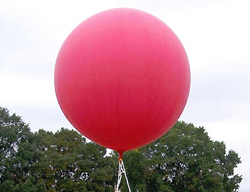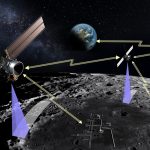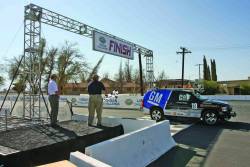 Want to win $40k? DARPA gives you one day to locate 10 of these 8-foot weather balloons moored across the USA
Want to win $40k? DARPA gives you one day to locate 10 of these 8-foot weather balloons moored across the USA(Updated December 7, 2009) A Massachusetts Institute of Technology team won the DARPA Network Challenge on Saturday, December 5. They took home a $40,000 cash prize from the Defense Advanced Research Projects Agency.
The team successfully located 10 eight-foot diameter, bright red weather balloons moored in plain site at locations across the United States.
Apparently, the DARPA personnel in charge were sensitive to frigid winter weather in the heartland – most of the balloons turned out to be moored in pleasant places for an outdoor December search: Portland, Oregon; San Francisco and Santa Barbara, California; Scottsdale, Arizona; Katy, Texas; Memphis, Tennessee; Atlanta, Georgia; Miami, Florida; Charlottesville, Virginia; and Christiana, Delaware.
(Updated December 7, 2009) A Massachusetts Institute of Technology team won the DARPA Network Challenge on Saturday, December 5. They took home a $40,000 cash prize from the Defense Advanced Research Projects Agency.
The team successfully located 10 eight-foot diameter, bright red weather balloons moored in plain site at locations across the United States.
Apparently, the DARPA personnel in charge were sensitive to frigid winter weather in the heartland – most of the balloons turned out to be moored in pleasant places for an outdoor December search: Portland, Oregon; San Francisco and Santa Barbara, California; Scottsdale, Arizona; Katy, Texas; Memphis, Tennessee; Atlanta, Georgia; Miami, Florida; Charlottesville, Virginia; and Christiana, Delaware.
Because the balloons were only displayed for one day during daylight hours, an organized strategy was key to winning.
Riley Crane, a post-doctoral researcher at MIT, led the winning team. They used a reverse pyramid strategy, offering $2 thousand to anyone who located a balloon, $1 thousand to the person who invited the finder to participate, and other cash prizes down the line. Crane’s research involves social networking and he has authored papers on the YouTube phenomenon.
DARPA’s latest competition was first announced on October 29, the 40th anniversary of the first message sent via ARPANET — the precursor to the Internet developed by the agency — to underline its expectation that participants would link up via the Web.
“The DARPA Network Challenge explores the unprecedented ability of the Internet to bring people together to solve tough problems,” said the agency’s director, Regina Dugan.
The Network Challenge rules characterized the activity as “a competition that will explore the role the Internet and social networking plays in the timely communication, wide area team-building and urgent mobilization required to solve broad scope, time-critical problems.”
Indeed, a number of websites were set up to gather balloon-seekers in common efforts: <http://findtheredballoons.com>, <http://theredballoons.com>, and <http://10redballoons.com> . A Facebook group formed for the same purpose and another site provided a Google map for posting balloon locations.
Although use of a GPS-equipped phone or portable navigation device probably represents the easiest way to precisely located the balloons in the required lat/lon degree-minute-second format, a FAQ on the DARPA challenge website suggested that street addresses and degree decimal formats can be converted to latitude and longitude using Internet conversion tools.
The Network Challenge continues DARPA’s recent efforts to harness the collective expertise represented among the Internet’s billions of users. Last March, the agency set up a mini-site on Facebook.com. Its first posting featured the DARPA Grand Challenge that in 2004 and 2005 invited teams to construct robotic vehicles that could navigate a stretch of desert in California and Nevada.
In the ensuing months on its Facebook site, the agency has posed a series of questions, such as: What technology(ies) could be combined with airborne sensor capabilities to generate completely new capabilities?
On July 16, the agency solicited ideas for a future DARPA challenge. Nothing like 10 Red Balloons appeared in the 52 responses (more than half submitted by one viewer) generated in response to the query.
However, a DARPA question in October did generate a reply with some notable parallels. The agency asked “How would you quickly train military personnel to understand the interaction between the economic, social, cultural, and religious aspects of a particular community or urban area?”
To which a viewed named “Heather” offered this suggestion: “Utalize [sic] geographic location identification of source social network media posts ie Twitter posts, facebook, linkedin, and myspace ect [sic] from a specific region, and write coding to allow live feeds of these posts into the aforementioned game module creating a realtime context of the moods, events, and culture of the designated area or region.”
The short lead time for the Network Challenge caused some competitors to say it couldn’t be done – there wasn’t sufficient time to gather enough willing eyes to scan the estimated 6.1 million miles of paved highways in the United States.
A viewer named John Hancock posed the viral communications challenge this way: “To win this you need to tell 2 people (post it on your Facebook page). Then those 2 people need to tell 2 NEW people and if you reach 29 levels thus 2^28 = 268,435,456 – 1 people…. should be enough to cover the US…”
A poll on the DARPA website elicited a substantial amount of skepticism in the task. “How long will it take to solve the DARPA Network Challenge? Fifteen percent answered “Never.” (Never say "never"!)





